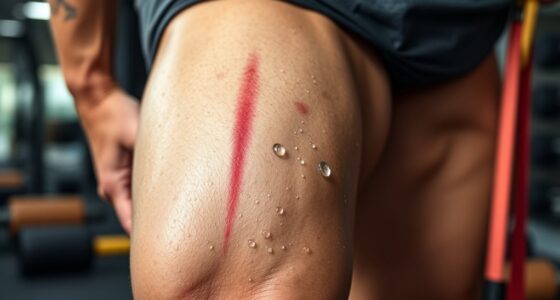Resistance training boosts bone density by applying mechanical load that stimulates osteocytes to sense force through mechanosensitive channels. These cells trigger signals that activate osteoblasts, promoting bone formation via pathways like Wnt/β-catenin and growth factors such as BMPs and IGFs. Consistent, appropriately intense exercises enhance molecular responses, resulting in stronger, denser bones. If you want to understand how these biological processes work together to improve skeletal health, keep exploring these mechanisms in detail.
Key Takeaways
- Mechanical load from resistance training stimulates osteocytes’ mechanosensitive channels, promoting biochemical signals for bone remodeling.
- Activation of osteoblasts during resistance exercises enhances bone matrix synthesis and increases bone formation.
- Growth factors like BMPs and IGFs regulate osteogenesis by promoting stem cell differentiation and osteoblast activity.
- Mechanical stress triggers signaling pathways (e.g., Wnt/β-catenin) that upregulate osteogenic gene expression and protein production.
- Proper training parameters and recovery optimize hormonal responses and mechanical stimuli, leading to increased bone density.
The Impact of Mechanical Load on Bone Cells

Mechanical load plays a crucial role in stimulating bone cells to maintain and improve bone density. When you engage in resistance training, your muscles generate force that puts stress on your bones. This mechanical load signals your bone cells to reinforce their structure, increasing bone density over time. As your muscles grow stronger, they apply more force, further enhancing this process. This continuous cycle of stress and response keeps your bones resilient and less prone to fractures. By regularly challenging your muscles, you not only boost muscle strength but also promote the health of your bones. The more mechanical load you introduce through weight-bearing exercises, the more effectively your bones adapt, leading to stronger, denser bones and better overall skeletal health. Additionally, understanding the mechanisms of osteogenesis can help optimize training strategies for bone health, especially when combined with appropriate resistance levels.
Osteocytes: The Bone’s Mechanosensors

Osteocytes are the primary cells responsible for sensing mechanical forces within your bones. They detect stress and strain through tiny channels called mechanosensitive channels, which respond to changes in bone fluid flow. When you engage in resistance training, the mechanical load causes fluid within the bone matrix to move, stimulating these channels. This fluid movement triggers osteocytes to send signals that influence bone remodeling, promoting either formation or resorption. The mechanosensitive channels act as sensors, converting physical forces into biochemical responses. By continuously monitoring mechanical stimuli, osteocytes coordinate the activity of other bone cells, ensuring your skeleton adapts to increased loads. This mechanism is crucial for maintaining bone strength and density, especially during resistance training when mechanical forces are consistently applied. Additionally, proper nutrition supports osteocyte function and enhances the bone remodeling process. Understanding how mechanotransduction works emphasizes the importance of balanced exercise and nutrition for optimal bone health.
Activation of Osteoblasts and Their Role in Bone Formation

When bones need to grow or repair themselves, osteoblasts are the key players that drive new bone formation. You can activate these cells through mechanical stress, prompting osteoblast differentiation. Once activated, they begin bone matrix synthesis, laying down the foundational mineralized structure. This process is essential for maintaining bone density and strength. As osteoblasts mature, they produce collagen and other proteins crucial for creating a sturdy matrix. Their activity is closely linked to resistance training, which stimulates bone remodeling and growth. Key aspects include:
- Initiation of osteoblast differentiation
- Increased bone matrix synthesis
- Collagen production for structural support
- Mineralization process facilitation
- Contribution to overall bone strength and density
- Understanding bone health is essential for effective training and prevention of osteoporosis.
Signaling Pathways Triggered by Mechanical Stress

When you apply mechanical stress to your bones, it activates specific signaling pathways that promote bone growth. This mechanical strain triggers osteogenic signal cascades, leading to increased osteoblast activity. Understanding these pathways helps explain how resistance training enhances bone density. Additionally, the cellular response to mechanical stress involves the activation of mechanotransduction mechanisms that convert physical forces into biochemical signals. Techniques like crochet and fabric decorating markers can be used as protective and creative outlets that support overall well-being, which may indirectly influence bone health. Research indicates that HEPA filtration and other air purification technologies improve indoor air quality, potentially benefiting bone health by reducing inflammation and pollutants that negatively affect skeletal systems.
Mechanical Strain Activation
Have you ever wondered how mechanical stress translates into biological signals within bone tissue? When you apply mechanical strain through resistance training, it triggers cellular responses that promote bone mineralization and mechanical adaptation. This process begins with the deformation of the bone matrix, activating mechanosensors on osteocytes. These sensors send signals that stimulate osteoblast activity. The key pathways involved include:
- Stretch-activated ion channels opening
- Integrin-mediated signaling cascades
- Cytoskeletal rearrangements
- Activation of mechanosensitive transcription factors
- Release of growth factors like TGF-β and IGF-1. Additionally, the process is influenced by the mechanotransduction mechanisms that convert physical forces into cellular responses. These mechanisms involve complex signaling networks that translate mechanical forces into biochemical cues, encouraging bone formation and strength. Research shows that antioxidant-rich berries can support overall brain health, which is essential for maintaining motivation and mental clarity during physical training. This process highlights how your bones adapt structurally to withstand increased load, reinforcing their density through mechanical strain activation.
Osteogenic Signal Cascades
Mechanical stress initiates a series of osteogenic signal cascades that drive bone formation. When you apply resistance training, it activates cellular pathways involving molecules like Wnt/β-catenin and MAPK, which promote osteoblast activity. These cascades are influenced by genetic factors that determine how responsive your bones are to mechanical stimuli. Dietary influences, such as adequate calcium and vitamin D intake, enhance these signaling pathways, supporting bone synthesis. Mechanical stress also reduces osteoclast activity, balancing bone resorption. Your genetic makeup may modulate the strength of these cascades, affecting overall bone health. Recognizing how these signals interact underscores the importance of combining resistance exercise with proper nutrition and understanding individual genetic factors to optimize osteogenesis. Additionally, understanding the signaling pathways involved can lead to targeted therapies for bone diseases and improve resistance training protocols.
The Role of Growth Factors in Osteogenesis

Growth factors play a critical role in osteogenesis by signaling stem cells and osteoblasts to proliferate, differentiate, and produce new bone tissue. They regulate this process through growth factor modulation, ensuring proper bone formation. These factors influence osteogenesis biomarkers, which help track bone growth activity. You should understand that specific growth factors, like BMPs and IGFs, are essential for stimulating osteoblast activity. They also enhance mineralization and matrix synthesis, indispensable for sturdy bones. By activating signaling pathways, growth factors coordinate cellular responses necessary for bone regeneration. You can monitor the effectiveness of osteogenic processes by measuring osteogenesis biomarkers, which reflect the activity of these growth factors. Additionally, recent research highlights the importance of AI-enhanced diagnostics in improving the precision of bone health assessments. Incorporating targeted growth factor therapies can further optimize bone repair and density through personalized treatment strategies. Furthermore, understanding the regulation mechanisms of these growth factors can aid in developing more effective therapeutic interventions. Overall, growth factor regulation is central to optimizing bone repair and density through targeted interventions.
The Influence of Resistance Training Intensity and Duration

You need to understand how training intensity and duration impact your bone health. Using the right load thresholds can maximize benefits without risking injury, while longer sessions might not always mean better results. Let’s explore how balancing these factors can optimize your resistance training for stronger bones. Incorporating effective communication techniques can also enhance motivation and adherence to your training regimen.
Optimal Load Thresholds
Determining the ideal load thresholds for resistance training is essential for maximizing bone density improvements without risking injury. You need to find the right resistance thresholds that stimulate osteogenesis effectively. Too light, and your bones won’t get enough stimulus; too heavy, and you risk overtraining or injury. The goal is to challenge your bones without crossing into unsafe territory. Incorporate sound vibrations and other healing sciences to enhance recovery and adaptative responses. Additionally, understanding optimal training parameters can help tailor exercises to individual needs. – Use weights that allow 8-12 repetitions before reaching fatigue – Focus on progressive overload to enhance resistance thresholds gradually – Incorporate weight-bearing exercises targeting major bones – Monitor your response to avoid excessive strain – Adjust intensity based on your progress and comfort levels – Recognize the importance of proper form and technique to prevent injury and optimize results
Training Duration Effects
The duration and intensity of resistance training substantially influence its effectiveness in improving bone density. Longer training periods with sufficient intensity promote osteogenesis by providing consistent mechanical stress, which stimulates bone formation. However, ideal results also depend on hormonal regulation, as resistance exercise can influence hormones like growth hormone and testosterone, supporting bone growth. Adequate dietary calcium is essential to maximize these effects, ensuring the body has the necessary mineral for bone remodeling. Short or inconsistent training may not produce sustained hormonal responses or mechanical stimulation needed for significant density gains. Consequently, balancing training duration, intensity, and recovery, along with maintaining proper calcium levels, enhances osteogenic outcomes and promotes long-term skeletal health. Regular physical activity and exercise consistency are crucial factors in achieving optimal bone health.
Molecular Changes Induced by Mechanical Loading

Mechanical loading triggers a cascade of molecular responses within bone tissue that promote adaptation and strengthening. You activate specific cellular pathways that lead to changes in gene expression and protein synthesis, essential for osteogenesis. These responses include increased production of growth factors and signaling molecules that stimulate osteoblast activity. Automation technologies enable scalable and flexible responses to mechanical stimuli, further enhancing bone adaptation.
Mechanical loading activates cellular pathways that enhance gene expression and promote bone formation.
- Upregulation of osteogenic genes like RUNX2 and BMPs
- Enhanced synthesis of collagen and other matrix proteins
- Activation of signaling pathways such as Wnt/β-catenin
- Increased production of cytokines promoting bone formation
- Modulation of cellular mechano-sensors that detect load changes
These molecular changes enable bone cells to adapt quickly to mechanical stress, reinforcing bone structure. Understanding these responses clarifies how resistance training stimulates bone growth at a cellular level, ensuring your bones become stronger with consistent mechanical loading.
Long-term Effects of Resistance Exercise on Bone Remodeling

Long-term resistance exercise induces sustained changes in bone remodeling, leading to increased bone mass and improved structural integrity. These adaptations support better metabolic health by enhancing bone’s ability to regulate minerals and reduce fracture risk. Consistent training stimulates osteoblast activity, promoting bone formation over resorption. Nutritional influences, such as adequate calcium and vitamin D intake, amplify these benefits by providing essential nutrients for bone repair. Over time, resistance exercise helps maintain bone density, especially during aging when natural decline accelerates. You’ll notice that persistent mechanical loading not only strengthens bones but also positively impacts overall health. To maximize long-term effects, combine resistance training with proper nutrition and lifestyle habits. This integrated approach ensures sustained improvements in bone quality and resilience.
Frequently Asked Questions
How Does Resistance Training Compare to Other Osteoporosis Prevention Methods?
You might wonder how resistance training stacks up against other osteoporosis prevention methods. It actively stimulates bone growth, unlike solely relying on nutrition support or medication. Combining resistance exercises with proper nutrition and medication synergy enhances bone strength more effectively. While medications can slow bone loss, resistance training directly promotes osteogenesis. Together, these strategies create a thorough approach to prevent osteoporosis, making physical activity a crucial component of your bone health plan.
Can Resistance Training Benefit Individuals With Existing Bone Density Issues?
You can definitely benefit from resistance training if you have existing bone density issues. It promotes bone health by stimulating osteogenesis, which helps strengthen your bones. Just guarantee exercise safety by starting with low weights and proper form to prevent injury. Consistent resistance workouts can slow bone loss and improve overall strength, making daily activities easier and reducing fracture risk. Always consult your healthcare provider before beginning new exercise routines.
What Are the Optimal Exercise Protocols to Maximize Osteogenesis?
Did you know that moderate resistance training can increase bone density by up to 3% annually? To maximize osteogenesis, you should focus on progressive overload—gradually increasing resistance to challenge your bones. Incorporate exercise variety, such as weightlifting, plyometrics, and bodyweight moves, to stimulate different bone regions. Consistency and proper technique are key, so tailor your routine to continually push your limits safely for ideal bone health benefits.
How Quickly Can Bone Density Improvements Be Observed With Resistance Training?
When you start resistance training, you might notice bone density improvements within a few months. Bone remodeling responds to mechanical stimulation, which encourages osteogenesis. Your bones adapt relatively quickly to this stimulation, often showing measurable changes in 3 to 6 months. Consistent, progressive exercises enhance this process, ultimately strengthening your bones. Keep in mind, individual factors like age and health influence how fast these benefits appear.
Are There Genetic Factors Influencing Response to Mechanical Loading?
Did you know that genetic predisposition can influence how your bones respond to mechanical loading? Your genes play a role in determining the effectiveness of resistance training on bone density. This means personalized interventions might be necessary for ideal results. Understanding your genetic makeup helps tailor exercises that maximize osteogenesis, making your efforts more efficient. So, your unique genetic profile could be the key to improving bone health through targeted resistance training.
Conclusion
If you commit to resistance training, you can considerably boost your bone density. Studies show that just 12 weeks of consistent exercise can increase bone mineral density by up to 2%. Imagine strengthening your bones enough to reduce fracture risk and improve overall health. By understanding these mechanisms, you hold the power to actively shape your bone health. So, lift, push, and resist—your bones will thank you for it.









